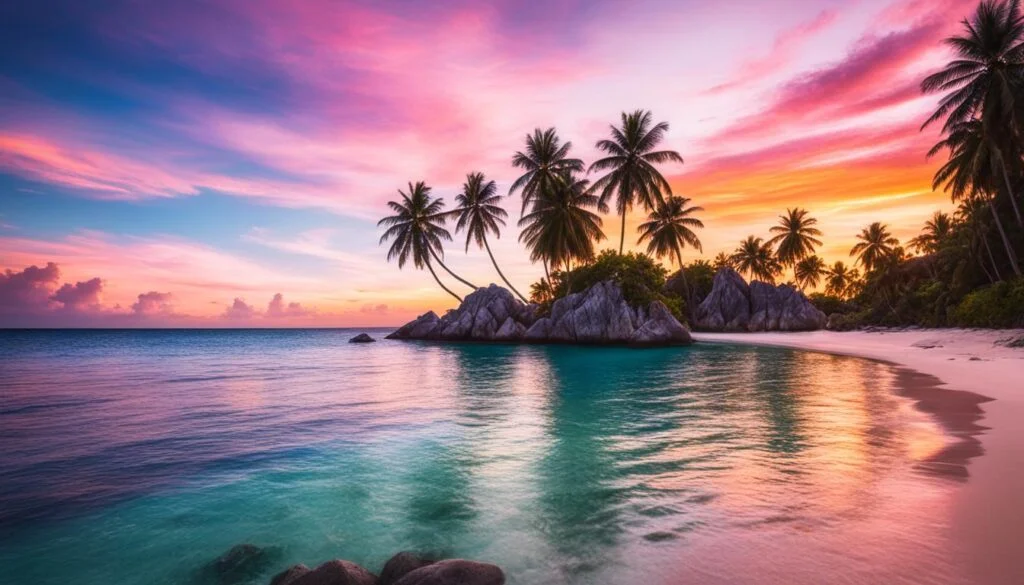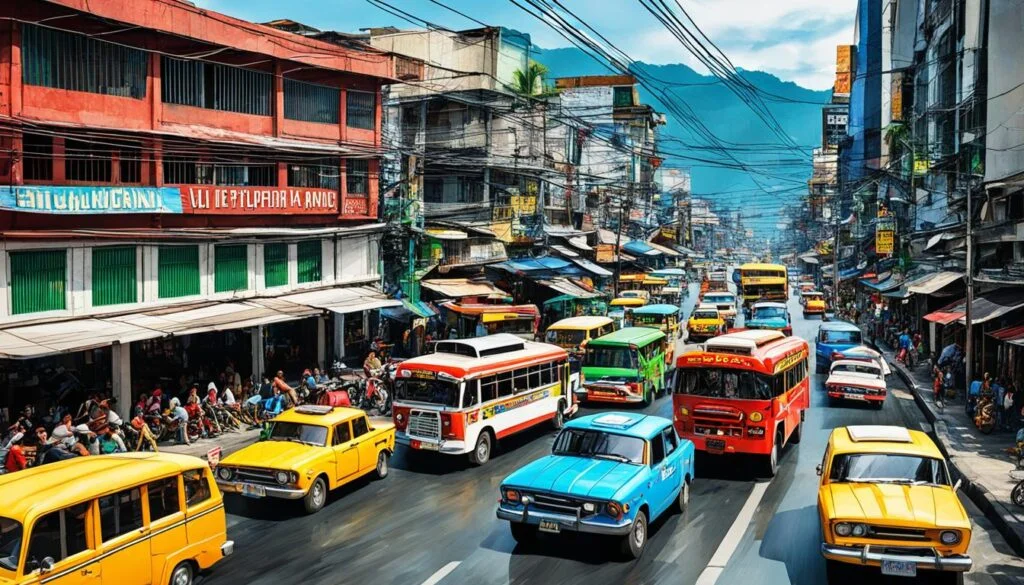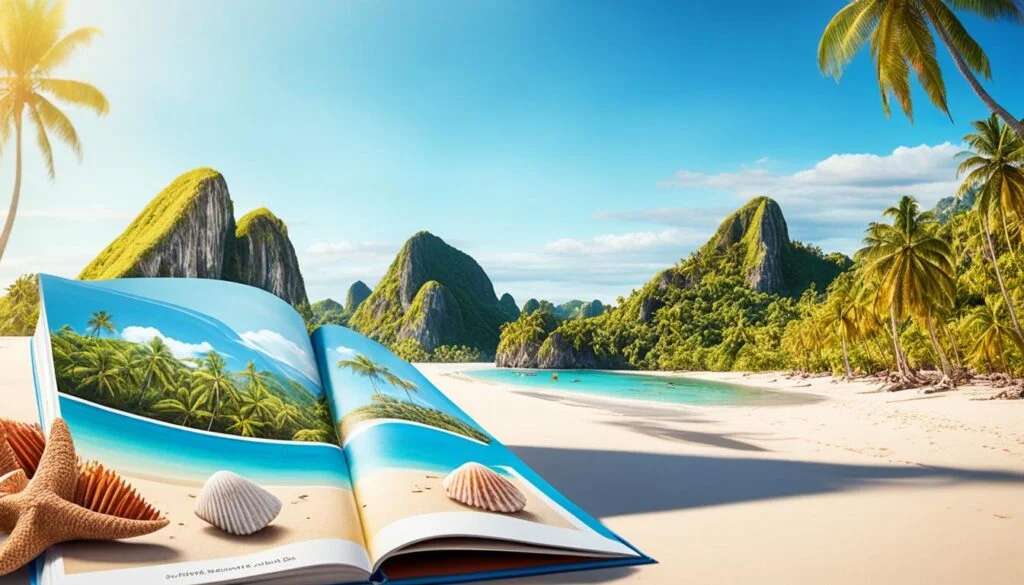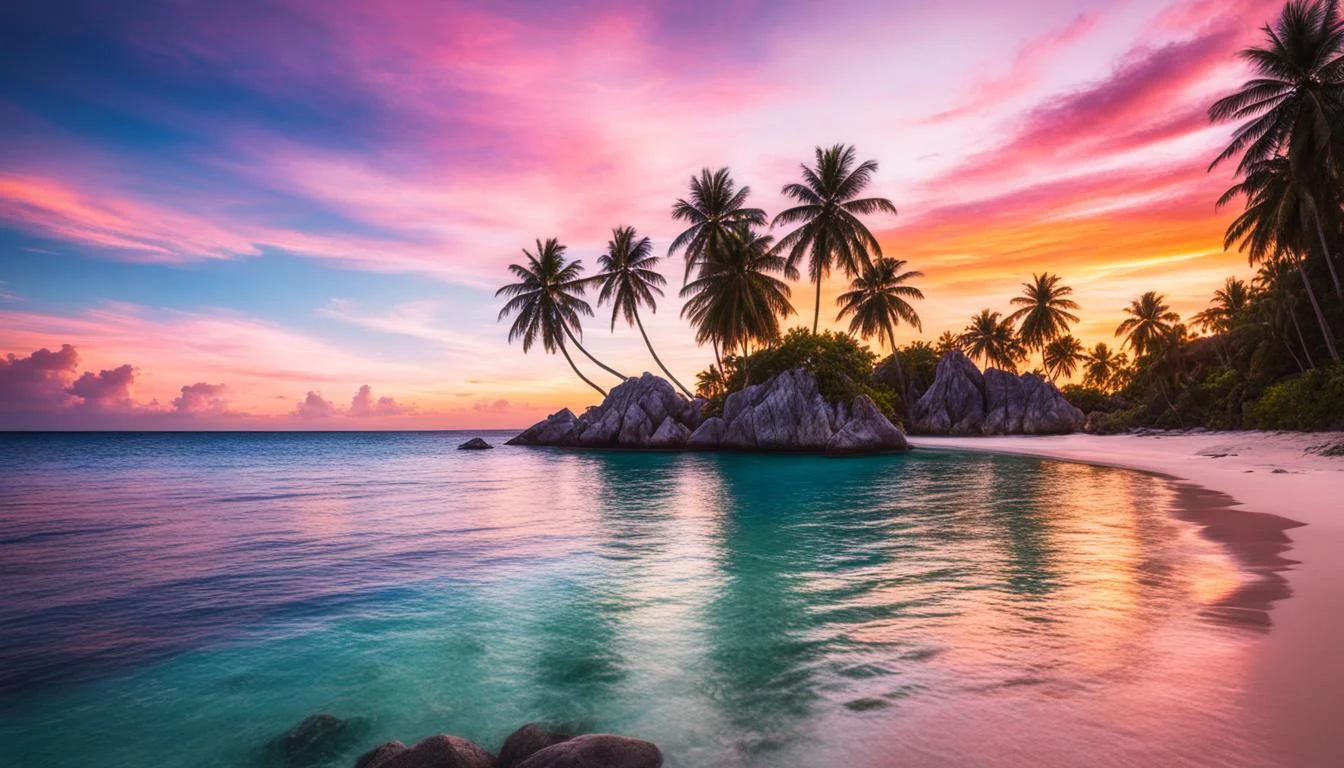Are you dreaming of a tropical paradise filled with stunning beaches, vibrant culture, and mouthwatering cuisine? Look no further than the Philippines, a captivating archipelago that promises an unforgettable adventure. This comprehensive guide, spanning approximately 2,500 words and taking roughly 30 minutes to read, will equip you with all the insights and tips you need to plan the ultimate Philippines vacation.
Comprising more than 7,500 islands and 81 provinces, the Philippines is a diverse and enchanting destination that beckons travelers from around the world. With over 180 languages spoken and a rich cultural heritage, this archipelagic country, located east of Vietnam and north of Borneo and Indonesia, offers a truly unique and immersive experience.
Page Contents
ToggleKey Takeaways
- The Philippines is a diverse archipelago with over 7,500 islands and 81 provinces
- The country has a rich cultural heritage with over 180 languages spoken
- Foreign tourists can enter the Philippines without a visa, and children under 18 are exempt from proof of vaccination
- The peak tourist season is during April and May, while the monsoon season runs from June to November
- The Philippines offers a variety of top destinations, including Palawan, Boracay, and Manila
Best Time to Visit the Philippines
When it comes to the best time to visit the Philippines, there are a few key factors to consider. The peak tourist season typically falls during the months of April and May, when the weather is generally sunny and dry. However, this period also coincides with the higher prices and larger crowds. The shoulder season, which runs from May to November, can be a great time to visit, with fewer tourists and more affordable prices. On the other hand, the monsoon season, from June to November, is characterized by increased rainfall and a higher risk of typhoons, making it a less ideal time for travel.
Ultimately, the best time to visit the Philippines depends on your preferences and travel goals. If you’re looking to avoid the crowds and save some money, the shoulder season or low season (June to September) may be the ideal choice. But if you’re hoping for the best weather and most vibrant atmosphere, the peak season of April and May could be the perfect fit.
Getting Around the Philippines
Navigating the Philippines can be an exciting and rewarding experience, but it’s important to understand the various transportation options available. Domestic flights are a popular and efficient way to travel between the country’s many islands, with Palawan being a particularly well-connected destination. For those seeking a more adventurous journey, ferries and boats are also a common mode of transportation, allowing you to soak in the stunning island landscapes.
It’s worth noting that while Wi-Fi and electricity are generally available in the Philippines, they can be considered commodities in some areas, with some islands experiencing intermittent power during the day. Additionally, ATMs can be temperamental, so it’s recommended to always carry cash on hand.
Top Destinations and Experiences
The Philippines is a treasure trove of amazing destinations and experiences, each one offering a unique glimpse into the country’s rich cultural tapestry. From the turquoise lagoons and majestic limestone cliffs of El Nido in Palawan to the vibrant food and arts scenes of Manila, there is something for every type of traveler.
For nature enthusiasts, Palawan stands out as a must-visit destination, with over 1,700 unspoiled islands to explore. The Underground River in Puerto Princesa, a UNESCO World Heritage Site, is a true natural wonder. Cebu, another key island, is renowned for its world-class scuba diving, with locations like Oslob offering the opportunity to encounter whale sharks. And for those seeking a more off-the-beaten-path experience, the mystical island of Siquijor is sure to captivate.
No matter your interests, the Philippines has a wealth of experiences waiting to be discovered, from the bustling energy of Manila to the serene beauty of Palawan and beyond.
Conclusion
The Philippines is a destination that truly has it all – stunning natural beauty, vibrant culture, and mouthwatering cuisine. With this comprehensive travel guide, you’ll be well-equipped to plan the ultimate Philippines adventure, whether you’re seeking relaxation on pristine beaches, thrilling outdoor activities, or immersive cultural experiences.
So what are you waiting for? Start planning your dream vacation to the Philippines today and get ready to be captivated by this enchanting archipelago.
Introduction
The Philippines is an archipelagic country located in Southeast Asia, consisting of over 7,640 islands. It is known for its beautiful beaches, diverse cultural heritage, and friendly local people. This travel guide aims to provide you with all the information you need to plan an unforgettable trip to the Philippines, from the best time to visit to the top destinations and experiences. Whether you’re a first-time visitor or a seasoned traveler, this guide will help you make the most of your time in this stunning vacation planning destination.
The Philippines can be divided into three main areas: Luzon, which includes Manila; the Visayas group of islands such as Panay, Negros, Cebu, Bohol, Leyte, Samar, and Masbate; and Mindanao, the second-largest island. With over 7,640 islands, the country is an archipelago with a diverse range of landscapes, cultures, and experiences to explore.
From the towering Mount Apo, the highest mountain in the Philippines at 2,954 meters (9,692 feet), to the stunning white-sand beaches of Boracay and Palawan, the Philippines offers a wealth of natural wonders and outdoor adventures. Whether you’re interested in scuba diving, hiking, or simply relaxing on the beach, this travel guide will help you discover the best the Philippines has to offer.
So, get ready to embark on an unforgettable journey through the Philippines and let this travel guide be your trusted companion as you explore this captivating vacation planning destination.
Best Time to Visit the Philippines

When it comes to planning the *best time to visit the Philippines*, it’s important to consider the country’s distinct seasonal patterns. The Philippines has two main seasons: the dry season from *November to June*, and the *wet season* from *July to October*.
The *dry season*, particularly from *January to March*, is generally regarded as the *peak season* and the *best time to visit the Philippines*. During these months, the weather is cooler and less humid, making it an ideal time for outdoor activities and island-hopping.
The *summer months of April to June* are also popular, but the *heat and humidity* can be intense. The *wet season* can be challenging due to the increased likelihood of *typhoons and heavy rainfall*, but it also offers the opportunity to see the country’s *lush, green landscapes* and experience local festivals.
Travelers looking to avoid the *peak season crowds* and take advantage of *lower prices* may consider the *shoulder months* of *May and October*, which offer pleasant weather and fewer tourists.
Ultimately, the *best time to visit the Philippines* will depend on your travel preferences and the activities you plan to enjoy. Whether you’re seeking *cool, dry weather* or *lush, green landscapes*, the Philippines has something to offer year-round.
Getting Around the Philippines

Navigating the Philippines can be an exciting adventure, with a diverse range of transportation options available to explore this archipelagic nation. The country consists of more than 7,000 islands, which makes it ideal for island hopping and suggests a need for packing lightly. Many airports around the Philippines require domestic or international terminal fees, typically around 200PHP. Weather, cancellations, and traffic can significantly affect travel times in the Philippines, potentially leading to delays and missed flights. To avoid penalties or issues with connecting flights due to delays or cancellations, travelers should obtain signed proof from officials such as coastguards.
The main airport hub is Manila, where most international flights arrive. From there, visitors can catch domestic flights to other major destinations in the country. For island-hopping, ferries and boats are a common mode of transportation. Buses, jeepneys (a type of colorful, locally-made vehicle), and taxis are also widely available, although the quality and reliability can vary. English is widely spoken in the Philippines, making it easier for tourists to communicate with locals.
Visitors are advised to plan their travel routes and schedules carefully, as transportation can be affected by weather conditions and other factors. Water quality issues in destinations like El Nido necessitate caution with drinking tap water and recommend the use of bottled water even for brushing teeth. Advice includes getting windows seats on flights for scenic views of the islands and taking warm clothing as air conditioning can be intense.
The Central Visayas region in the Philippines is home to Bohol and Panglao islands. Balicasag Island, known for its diving sites, is a 20-minute boat journey from Alona Beach in Panglao. Bohol is home to over 1,200 Chocolate Hills, a popular tourist attraction in the region. Siquijor Island, located in the southern Visayas, is accessible only by ferry, and Siquijor has no airports, making ferry travel the primary mode of transport to and from the island.
Banaue, situated in the Cordillera Mountains, features the Banaue Rice Terraces, a UNESCO World Heritage Site, and Batad, a village near Banaue, is only accessible by hiking and is a popular overnight destination for visitors to the region.
Coron is a popular destination with activities like island hopping and hiking, and El Nido offers pristine white beaches and paradise islands. Popular ways to travel from Coron to El Nido include ferry rides and expeditions with Big Dream Boatman. Cebu is a main transport hub in the Philippines, and day trips can be taken to explore Bohol, known for its unique landscapes and the Philippine Tarsier.
Siquijor is renowned for its waterfalls, friendly locals, and scenic drives, and Siargao is considered the ‘Most Beautiful Island in Asia’ offering surfing and island hopping. Traveling within the Philippines is affordable and accommodation fits every budget, but Wifi in the Philippines is unstable, so getting a SIM card is recommended.
Philippines travel guide

When traveling to the Philippines, it’s crucial to be aware of the country’s cultural customs and safety considerations. English is widely spoken, but it’s helpful to learn a few basic Filipino phrases. Respect local customs, such as removing your shoes when entering homes or temples.
Be cautious when withdrawing cash, as ATMs may not be widely available on smaller islands. Dress modestly, especially when visiting religious sites. While the Philippines is generally safe for travelers, it’s important to stay vigilant and avoid certain areas that are known for political or security issues.
The Philippines is comprised of more than 7,000 islands13 and has one of the world’s longest coastlines13. 76% of the population identifies as Roman Catholic13, and there are over a hundred ethnic groups in the country13. English and Filipino are the official languages, with over 170 distinct languages spoken13.
The Philippines grants 30-day visa-free entry to passport holders of certain countries. Most parts of the Philippines are considered very safe for travel, except for the far south regions. However, the country is at high risk for natural disasters such as cyclones, earthquakes, floods, landslides, tsunamis, volcanic eruptions, and wildfires.
Overall, embracing the local culture and being adaptable will ensure a smooth and enjoyable trip to the Philippines. By understanding the cultural customs and safety considerations, travelers can make the most of their Philippines travel guide.
Top Destinations and Experiences

The Philippines boasts a diverse array of stunning destinations and unforgettable experiences. Some of the top spots include the idyllic islands of Palawan, known for its clear turquoise waters and stunning limestone cliffs. The White Beach in Boracay, a world-famous beach destination with lively nightlife, holds a rating of 4.5 out of 5 bubbles with 6,604 reviews, making it one of the top attractions in the Philippines. Cebu, a hub for history, culture, and world-class diving, and Bohol, famous for its Chocolate Hills and tarsier population, also draw in a significant number of visitors.
Beyond the beaches, visitors can explore the vibrant capital of Manila, hike through lush rainforests, and immerse themselves in the country’s rich cultural heritage. The Puerto Princesa Underground River holds a rating of 4.5 out of 5 bubbles based on 5,773 reviews, while the Nacpan Beach boasts a rating of 4.5 out of 5 bubbles with 2,709 reviews, highlighting its popularity among visitors. The Chocolate Hills Natural Monument received a rating of 4.0 out of 5 bubbles from 2,817 reviews, showcasing its appeal to tourists.
Kayangan Lake maintains a rating of 4.5 out of 5 bubbles with 2,461 reviews as a top body of water attraction, and the Banaue Rice Terraces is rated 4.5 out of 5 bubbles and has garnered 1,002 reviews, highlighting its appeal to tourists. The Big Lagoon holds a rating of 4.5 out of 5 bubbles based on 1,750 reviews as a notable body of water attraction. Whether you’re seeking adventure, relaxation, or a mix of both, the Philippines has something to offer every traveler.
The culture in the Philippines celebrates diversity, warmth, and values like respect, family, and hospitality, with colorful festivals and traditional practices that reflect the nation’s dynamic spirit. For travelers seeking adventure, the Philippines offers a vibrant backpacking scene, adrenaline-pumping activities like trekking, diving, canyoneering, and surfing, making it a dream destination for thrill-seekers.
Conclusion
The Philippines is a captivating destination that offers a unique blend of natural beauty, cultural richness, and warm hospitality. From the stunning beaches and islands to the bustling cities and charming countryside, there is so much to discover in this remarkable country. Whether you’re seeking a relaxing beach getaway, an adventure-filled island-hopping experience, or a deep dive into the country’s rich cultural heritage, the Philippines is sure to leave a lasting impression.
By following the tips and insights provided in this comprehensive Philippines travel guide, you’ll be well on your way to planning an unforgettable trip. From navigating the best time to visit, to getting around the country, to exploring top destinations and experiences, this guide has covered all the essential information to help you make the most of your Philippines vacation. Start planning your dream Philippines travel today and get ready to be captivated by the country’s natural wonders, vibrant culture, and welcoming people.
Remember, the Philippines is a destination that offers something for everyone, whether you’re a Philippines travel planning enthusiast, a Philippines vacation seeker, or simply looking for a comprehensive Philippines travel guide summary. With its diverse landscapes, rich history, and unique experiences, the Philippines is a destination that will leave a lasting impression on all who visit.
FAQ
What are the best times of year to visit the Philippines?
The dry season from November to June, especially January to March, is generally considered the best time to visit the Philippines. The weather is cooler and less humid, making it ideal for outdoor activities and island-hopping. The summer months of April to June are also popular, but the heat and humidity can be intense. The wet season from July to October can be challenging due to the increased likelihood of typhoons and heavy rainfall.
What are the main transportation options in the Philippines?
The main airport hub is Manila, where most international flights arrive. From there, you can catch domestic flights to other major destinations. For island-hopping, ferries and boats are a common mode of transportation. Buses, jeepneys (a type of colorful, locally-made vehicle), and taxis are also widely available, although the quality and reliability can vary.
What cultural customs should I be aware of when traveling in the Philippines?
English is widely spoken, but it’s helpful to learn a few basic Filipino phrases. Respect local customs, such as removing your shoes when entering homes or temples. Be cautious when withdrawing cash, as ATMs may not be widely available on smaller islands. Dress modestly, especially when visiting religious sites. While the Philippines is generally safe for travelers, it’s important to stay vigilant and avoid certain areas that are known for political or security issues.
What are some of the top destinations and experiences in the Philippines?
Some of the top spots include the idyllic islands of Palawan, the world-famous beach destination of Boracay, the hub of Cebu for history, culture, and world-class diving, and Bohol, famous for its Chocolate Hills and tarsier population. Beyond the beaches, visitors can also explore the vibrant capital of Manila, hike through lush rainforests, and immerse themselves in the country’s rich cultural heritage.

